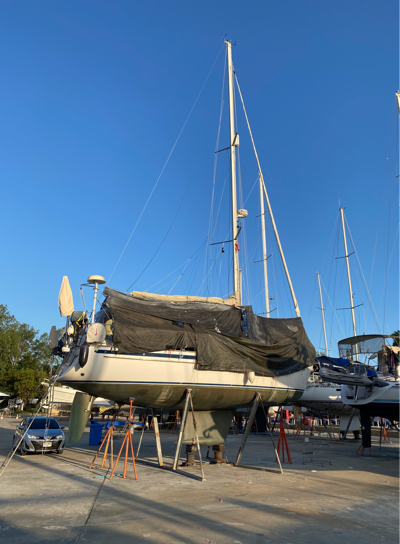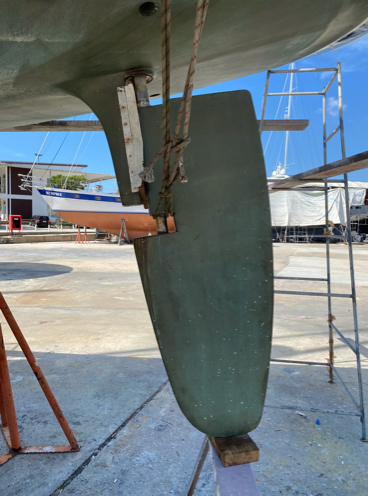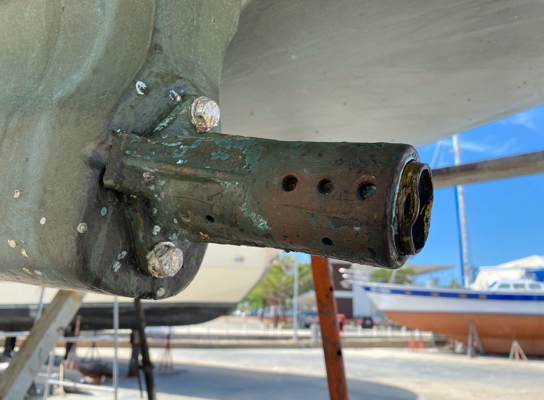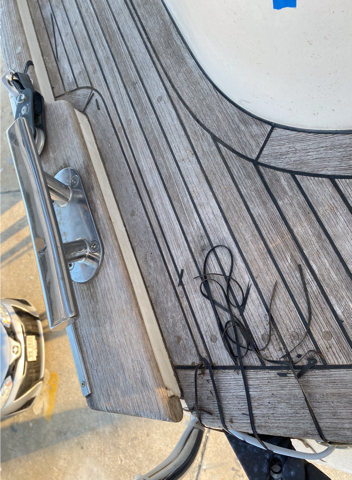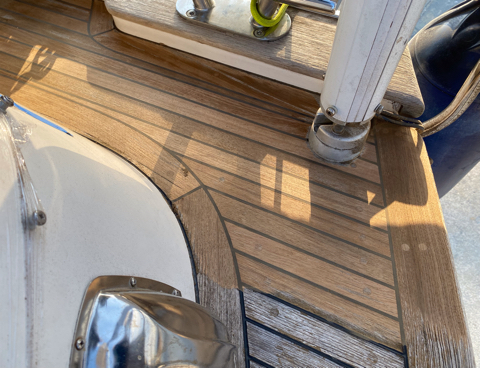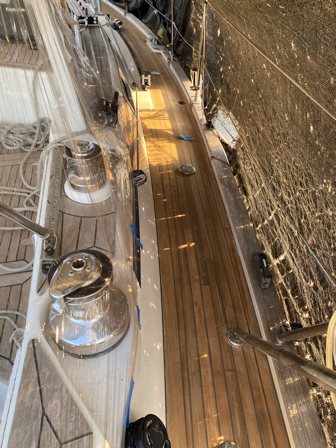Post Shakedown

Vega
Hugh and Annie
Wed 12 Jan 2022 04:23
The prime purpose of the shakedown sail was to test the tensions in the new rigging. Due to the lack of wind the rigging was about the only thing we were unable to test. We did encounter one nasty squall but were motoring at the time. However, after a stop in Chalong Bay to renew our visas, we had enough breeze just outside the marina to try some gentle upwind sailing. In about 12kts breeze (guesstimate due to lack of wind info) we sailed at 6kts with the sails setting perfectly - not a crease or wrinkle to be seen. Upwind in a gentle to moderate wind is Vega’s best point of sailing and the 150% genoa comes into its own. It’s funny, this sail, the original genoa, doesn’t seem as huge as we thought it was. It is still in very good condition. When the boat is heeled you can feel less tension in the leeward shrouds, even in only 12kts of wind. We did hit some swell and the bow slammed a little at which point the leeward forward lower shroud became slack as the mast flexed and snapped taut as it straightened again. This is the same issue that has given me the heebie jeebies over the years and I have cured by tightening the forward lowers. Our rigger Jai advises that this is the right thing to do. The fact that this is happening with the new rig I actually find reassuring. It means that the set up is similar to the original and we are now fine tuning from the same starting point. I think we need a tad more tension in the main shrouds and rather more in the forward lowers. If this is apparent on a flat sea in Phuket we don’t want to be caught out in the turbulent waters of the Indian Ocean! Jai will come to discuss and adjust but we hear he has just tested positive for Covid! In the meantime Vega is back on the hard. She needs to be high enough off the ground to allow the rudder to be dropped when the bearings are checked and looks very precariously perched on steel tubes with layers of wooden packing. The yard guys used a spirit level to ensure Vega was perfectly upright so seem to know what they are doing. My next shock was to discover that the cost of hauling out has increased dramatically for the dry season and we will have to pay the same as a 40 to 60 tonne gin palace. After what appears to be a light sanding the decks are looking like new! The Sikaflex sealant between the strips of teak was protruding (I don’t know if this was as a result of the teak shrinking or the Sikaflex expanding) but is obviously a common effect because the raised material is planed off in long strips before sanding. Ms Nai did advise that if there was an issue with the remaining sealant we would “need to talk again” but nothing heard so far. She is also replacing a section of the gunwhale on the port bow that was splitting along its length. The new piece is indistinguishable from the original (apart from not being split). The craftsmanship looks really impressive but unfortunately I didn’t have a camera this morning to capture the work in progress. The guys to maintain the steering, rudder and propshaft arrived on schedule. There was a lot of hammering to remove the prop hub which was a bit disconcerting. They dropped the rudder in order to remove the propshaft which meant releasing the bearing on the skeg (short vertical extension down from the hull to support the rudder - see photo). They pushed and pulled sideways on the rudder to indicate to me any movement in the rudder bearing in the hull. I took this to mean there was a problem but in fact it turns out this was to show that all is ok (I am hampered by a negative outlook and no Thai). We do however need a new cutlass bearing for the propshaft (within which the propshaft rotates where it leaves the hull). Also the water seal on the shaft is “looking tired”. I’m not sure exactly what this means but we don’t want to be setting out for four months with probably a lot of motoring with a tired water seal. The chandlery at the marina is the only authorised distributor in Thailand for our PSS type seal which would have been good news if a) they had one our size in stock and b) hadn’t closed after most of the staff tested positive for Covid. I did track down the manager and he said he would see if he could get one sent from the US which will mean yet more delay. I have also found someone who can import one within 7 days but at probably greater cost. The cost benefit analysis will be undertaken this morning. The electricians diagnosed our SeaTalk failure as failed output from the autopilot computer which could be repaired. Back in the workshop they decided this wasn’t the problem which they have now traced to the autopilot controller on the binnacle. Trying to suppress my negative outlook I called in at Octopus Electrical to talk through the options with Paul. There is an Australian dimension to nearly all the outfits we have used. The options are a replacement second hand unit (of unknown age) with a one week warranty for £300 or a new unit for £600. Paul touchingly thought I would fit the new unit myself but after he briefed me on the possibility of a wiring extension if required and the need to connect into the junction between the new and old versions of SeaTalk we have on board I nodded sagely but deferred to his guys to fit. Apparently the new unit won’t have full functionality as it is working with an older system. We discussed what the functionality is and as I had never heard of it, never mind used it it didn’t seem a major issue. The good news on the electrical front is that each of our two solar panels is still pushing out 4.5 Amps - they are rated at 5 Amps each. We are having a 12 Amp plug socket put into the rear cabin to give us the option of a small portable freezer. Annie is keen on this as the thought of completing our circumnavigation with both plenty of fresh water and frozen pre-cooked meals becomes irresistible! I just hope the chandlery reopens in time………… We have two working gas regulators but they are the type that screw directly into the gas bottle. This means that the working bottle will not fit into the gas bottle locker. We need flexible hose on either end of the regulator for the bottle plus regulator to fit. Without this we need to lash the working bottle into the open cockpit which causes an obstruction. The local chandleries stock the hose (which we already have) but not the regulator. We are hoping a trip to Wayne’s World - a new and second hand emporium run by an engaging London wheeler dealer - will solve the problem. The windlass is due back from its service today and while here the guy will replace the frozen ball valve in the heads washbasin seacock and re-set the fuel gauge level float. I can’t think of anything else that could possibly need fixing on board so we now just have to concentrate on provisioning, passage planning, background research on anchorages and so on for the Maldives while we hope and pray our shaft seal is both in stock in the US and arrives within the next week. We hired a car for three days. At less than £20 a day it’s cheaper than taxis. Things like accommodation, restaurant food, car hire, labour and so on are relatively cheap. Anything yachty and as soon as you engage the larger commercial outfits is on a par with prices all around the world. Vis the, in my mind, eye watering cost of £760 just to be hauled out (incl. back in). We are not on an unlimited budget but nevertheless accept that running a boat and sailing around the world is not cheap. Some manage this by ruthless cost management. Some supplement their income by vlogging on YouTube and very successfully too. Others try and do all or most of their own repair and maintenance. Our approach is to rely more upon professional support and to cover the cost by letting our house. This time we have yet to find a tenant and so are feeling the pinch until we do. Thailand is a good place to have work done before embarking upon the final legs home and the contractors are very busy at the moment. Some yachties take the opportunity to have work done that would be more expensive when back in Europe while others hope the work will maintain the value of their boats for sale when back home. We just want Vega in the best possible condition to get us home! One piece of good news is that Customs and Excise are rescinding the requirement to pay VAT again on yachts returning to the UK. If a yacht left the country for more than three years this was considered to be exporting the yacht. It was then “reimported” on return and this meant VAT had to be paid again on its estimated value on return to the UK. In practice C&E has always had discretion to waive this but the issue came to the fore with Brexit and the fact that yachts bought in the EU are no longer in the same VAT jurisdiction and so VAT will be payable when brought into the UK. This will still apply but yachts originally bought in the UK, VAT paid, and remaining in private ownership are no longer bound by the three year rule providing they aren’t imported into another country in the meantime. We have been careful to avoid this while Vega has been in Thailand by claiming exemptions from import duty with Thai customs. We have started to buy enough provisions to see us through three months or so in the Maldives. Looks like our diet will be based upon pasta, rice, tinned tomatoes and tuna. We try and stock up on the basics, including UHT milk and orange juice in the hope that we will come across fresh fruit and vegetables from time to time. We may even catch the odd fish! We are also filling out the required information and formalities for Maldives. Contact has been made with an agent who is widely recommended and all the paperwork has gone smoothly! We will now have to show a negative PCR test obtained within 72 hours of leaving Thailand but at least, as things stand, we will be allowed ashore! |
